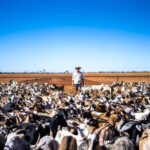Black Pearl is the new name to remember in mouse control for Australian farmers. The…
Using tech to combat crime

In September and October, NSW Farmers collaborated with WFI Insurance, NSW Police Force Rural Crime Prevention Team, and Meat and Livestock Australia to host nearly two dozen workshops across NSW, giving farmers opportunities to learn about what they can do on their properties to reduce the risk of rural crime, and to express their concerns about criminal activity in the agricultural sector.
Large properties in particular are at risk of being targeted by criminals, and security systems can be a visual deterrent to them. The same technology that’s used for security can also be used to monitor water infrastructure and identify when livestock are using it, fences, yards and machinery, and identify expected and unexpected visitors as they enter the property via the main gate. An alert can be transmitted to the operator, or an external security officer, for any of these situations.

Western region NSW Farmers regional service manager, Caron Chester, said rural crime costs landholders and businesses millions of dollars every year.
This was measured in theft and criminal damage and increased insurance premiums.
“Theft of livestock, produce, equipment and machinery, illegal shooting, trespass and other crimes affect people’s livelihood and wellbeing,” she says. “Reporting criminal activity is crucial to creating a secure and thriving environment for everyone.
“Simple security measures that deter criminal activity include locking trucks, tractors, sheds and petrol tanks and using permanent engraving to mark equipment.”
Presenting at one of the workshops, Detective Chief Inspector Cameron Whiteside said cameras are also a deterrent, and serve to identify and record criminal activity.
This is very helpful when it comes to identifying and prosecuting criminals.
Trespassing and theft
A common theme at the workshops hosted by NSW Farmers was trespassers identified as a significant issue, and theft was also a common link.
Surveillance systems was a common solution, and so was placing signs on fences and gates, warning of prosecution, in conjunction with surveillance systems.

When farmers first approach Earle Swan, of OES Systems, to discuss security and monitoring systems, he seeks to identify the services they actually need, to provide usability and value.
Earle said theft can vary from deconstructing a shed to its slab, and stealing everything in the shed as well, or stealing diesel from a tank, to theft of tractors and other machinery. Or monitoring who is walking or driving through gates.
“Alarm systems can be put on anything these days,” Earle says. “This includes on remote properties where security and surveillance may be challenging.
“OES Systems provides alarm monitoring and intrusion alarm systems on properties all around Australia,” he adds. “Camera systems can monitor gates, equipment and infrastructure. You may want to monitor a water source with a camera, but if you have 18km of water infrastructure that needs monitoring, you can also put technology on that. Tracking security hardware and software can be installed
into anything.
“OES Systems also provides alarm monitoring and intrusion alarm systems which communicate to a 24-hour monitoring centre.
“This means if someone is opening a tractor door at 2am in the morning, and overnight sowing or harvesting is not part of planned operations, the intrusion system will report in real time to the control room that someone is opening the
tractor door.”
The property owner or manager receives an instant alert on their mobile phone and by email of the activity and that an alert to police is pending.

“Current apps give you the flexibility to monitor your site from anywhere, at any time,” Earle says. “A key feature of our system is its ability to be customised and to integrate with other systems, so you end up with a comprehensive solution for monitoring and managing your site remotely.”
Monitoring assets, and biosecurity
Monitoring information provided by property owners has enabled criminal activities to be successfully prosecuted.
“Any security on a farm – from locking tractors and sheds to a comprehensive monitoring system – can make criminals think twice about targeting a farm,” says Caron Chester from NSW Farmers. “Some of the strategies are common sense, many of them are easy, and all of them make it harder for criminals to get away with crime.”
A point that came out of the workshop, was that landholders need to inform the workers on their property if cameras are installed.
Another common theme from attendees was biosecurity – especially how this was breached when people from off-farm handled livestock without the farmer’s knowledge.
MLA representatives discussed the integrity of the National Livestock Identification System (NLIS) and the importance of ear-tagging aimals for lifetime traceability.
Australia’s red meat industry’s Lifetime Production Assurance program manages on-farm food safety, animal welfare and biosecurity risks.
As livestock producers know, the national vendor declaration is a legal movement document that underpins and enables the NLIS database to track livestock movements around Australia.
The NLIS is crucial for biosecurity and food safety, and has an important role in investigating livestock theft.

George Basha, Integrity System Company, a subsidiary of MLA, said the NLIS database should make it easier to identify stolen livestock, and return them to their owners.
He said this was why all livestock location data and movements need to be recorded on the NLIS database. All livestock producers should also undertake an annual reconciliation of their data, to ensure accuracy.
There are a range of resources available to farmers on the NLIS website, at https://www.integritysystems.com.au/identification–traceability/national-livestock-identification-system/
MLA has recently undertaken a review of assets and is developing an app and other electronic information that is intended to make it easier for primary producers to use the NLIS and NVD systems.
Of course, using the NLIS database to identify stolen livestock depends on the thieves not cutting out and replacing the original tags on the stolen animals, which is a common practice.
Branding and other marks, such as notches and tattoos, are also helpful for recovering stolen animals that haven’t been slaughtered soon after they are taken. Police also use DNA to identify stolen livestock.
Other issues raised in the workshops included illegal hunting, machinery theft, drone activity, guns and cybercrime.
To read more about stopping rural crime, click here.








